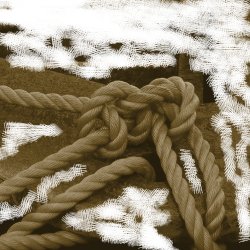Once, while exploring the planes of southern Africa, I came across a most astonishing civilization. The people there are highly advanced in most areas of technology (certainly relative to their savage neighbouring tribes), and yet they have not, it seems, discovered the noble art of writing.
“How then”, you ask, “can they record anything? The fallible memories of mankind alone surely cannot keep a sophisticated society functioning?”
They do have paintings and other arts and crafts, and historical event are often depicted on their pottery – but this is not their chief method of recording events – allow me to explain:
One day, shortly after my arrival, a nobleman invited me to their archives. I, having noticed the complete absence of anything like parchment or papyrus, accepted with great curiosity.
The archive itself carried the smell of a cotton mill, thick and musky, with fibres floating everywhere around. There were high sets of varnished shelves all around, and the aisles between them were quite narrow. But the shelves contained neither books nor scrolls; no, they were divided into small pigeonholes, each one maybe four inches across and two feet deep. And, in each pigeonhole, there was a knotted mass of twine.
He showed me all this before taking out one of these tangled bundles, then leading me outside so that I could see it in the open air. We sat down, and he examined it himself very intently, feeling it all around, occasionally pulling the more clotted parts of it open so that he could, somehow, “read” it more clearly, before handing it to me to examine. He said it described a battle that had happened, between other tribes, two generations ago.
The twine was not too coarse, and its ends were bound together with a small gold ring. I pointed at this ring, and asked the man what it meant. He said it did not pertain to the story in any way, and its only function was to fasten the two ends of the rope together.
Then, careful not to disturb the arrangement of the complicated mesh in my hands, I pointed to a cluster where the twine overlapped and tangled into itself much more densely than elsewhere.
“What significance does this have? Does this represent the battlefield?” I asked him.
The old man laughed, took the bundle of twine from me, and started tugging at the region I had specified, then started shaking the whole bundle rather roughly until it was in a different form to how it had been before.
“Where is that pattern now?” he asked, “What use would it be to have that represent anything if even a small child, toying with it, could alter it beyond recognition?”
This confused me greatly. “If,” I spoke, “if the section I pointed to didn’t mean anything, then what part of it has meaning? Surely any part I might assign meaning to can similarly then be pulled apart”.
He smiled; “Yes.” he said, “You see, we only ascribe meaning to the parts of the knot that cannot be changed by such trivial manipulations”.
“I do not understand then how anything can be communicated using these tangled masses”.
I had kept a notebook with me on my travels, and the old man must have seen me using it, for he then asked me to give it to him. He held it open on some pages at arm’s length on front of us.
He asked what it described. I read it out to him – it was a short note on the perennial flora of southern Italy. He then moved the book closer to us, and said “does it still describe the same thing?”
“Yes, of course”.
He stepped away from my side and turned the book away from me. “And now?”
I walked around to his side again, to see if he was playing some kind of elaborate trick, but it was still the same book, open on the same page.
“Yes, it is still the same. What are you getting at?”
“And, if posted to America and read there?”
“I’d expect so”.
“And if I close the book, somehow the information on this page is the same?”
“Obviously”.
“So, can you not understand that your book has properties not too much different from our knots – the main difference is that the descriptions contained in our knots are simply left unchanged under a wider variety of actions”
I nodded – I still did not understand, but it was making some sense anyway
“And just as you might change the size or colour of your typeface, or the proportions or quality of your paper, we might change the length, diameter, or quality of our twine, without effecting anything.”
He handed my notebook back me.
“However, what would happen if I was to take a page from your book, tear it up, and reassemble it back into a page of the same shape, would it’s meaning be still the same?”
“No”, I said, “indeed, it may not make any sense at all”.
“So it would be the same”, he said, holding the twine in one hand in front of me, “for if I was to cut this rope, alter it’s knots, and reattach the ends, the whole meaning of the knot might be lost”.








